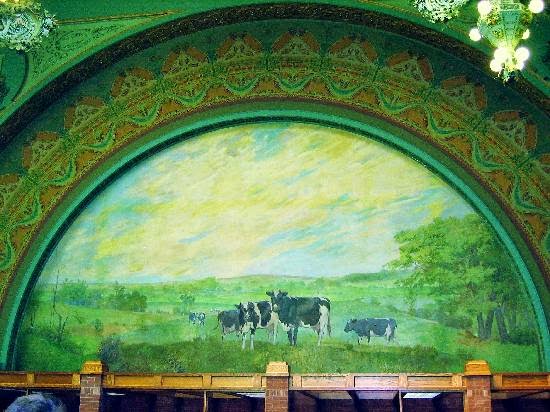National Farmer's Bank of Owatonna
Location: Owatonna, Minnesota
Architect: Louis Sullivan
Years Built: 1907-08
The National Farmer's Bank of Owatonna is a bank in the heartland of the Midwest that is one of the finest pieces of "Prairie School Architecture" in America.
Some early sketches of the building show what the mastermind architect Louis Sullivan was planning for the bank.
After two years of construction, the final product was one of the most influential and symbolic pieces of architecture the Midwest had ever seen.
 |
| "Jewel Box of the Prairie" |
At first look, the scale and symmetry are what first catch the eye. The National Farmer's Bank of Owatonna is massive, stately and in unforeseen order.
At a closer look, you can see the magnificent detail and complexity of the buildings intricacies.
 |
| "Symphony of Color" |
The green and brown rectangular panels and the blue glass
frames give the rusty brick wall a flash of the designer’s spirit. The intricate design of each panel portrays the thought and planning behind every inch of this masterpiece.
On the forty acres one can find the story of the design of the building, stretching all the way back to the architect's life and motivation behind the bank and its invaluable effect on Midwestern life.
"an entertaining history
that reflects the author's enthusiasm for the Owatonna bank building and his
admiration and sympathy for the people involved in its creation"
Though my interpretation of the bank is exponentially less brilliant than the original, the most highlighted feature of my image of the building is the beautiful green mosaic surrounding the stained glass arch.
Once inside the building, the most awe-inspiring aspect of the bank is the simple yet powerful mural of a cow in an open pasture.
 |
| "Roots" |
The cows in the field revoke nostalgia in all of the banks frequenters and create a sense of familiarity that gives each and every hardworking customer a personal connection to the bank.
Looking on Google Earth, you notice that the building is at the center of a small town square. There
are a few surrounding stores and establishments in the early twentieth century style town,
but beyond a half-mile radius it is solely open fields around the bank.
Once taken inside on a virtual tour, the aspect of the bank that stood out to me most was how
unbelievably detailed the entire structure is. Every nook, corner and crevice is absolutely dripping in detail.
This Flickr photo of a supporting structure on the inside of the building completely captures the pristine color scheme.
On MPR, Minnesota Public Radio, Bill Buzenberg expands on the subject of the National Farmer's Bank of Owatonna. He discusses all aspects surrounding the incredulity of the bank, but he specifically makes a point to include how as
the bank was being built, Sullivan wrote to the owner of the bank saying he wanted a "Color Symphony." Buzenberg agreed with the idea that the bank was wholeheartedly a symphony of color.
http://news.minnesota.publicradio.org/features/200002/28_buzenbergb_owatonna/
I could not agree more with the bank's optimal capturing of a perfect farmer's color scheme. The inside of the building perfectly alludes to everyday life in the heart of the Midwest.
In the New York Times, Robert Sharoff gives a history behind Sullivan's works, and explains some of the somewhat hidden yet fascinating aspects of the creation of The National Farmer's Bank of Owatonna.
Some takeaways from his article include:
2) Sullivan is best known for coining the phrase “form follows functions.”
3) The bank had to be an enormous success – Sullivan was an alcoholic with a downward spiraling career and a fleeting bank account.
Though I've never visited the building myself, Yukio Futagawa's account of his experience visiting sums up the first sight of the powerful piece of architecture that is The National Farmer's Bank of Owatonna.
"Stand back from the corner of Broadway and Cedar Streets in Owatonna, Minnesota. See how Sullivan's National Farmers' Bank stands on the corner opposite the park. Massive and stately—68 feet broad and about 53 feet tall—its silhouette and ornamental patterns strike golden section rectangles. Great vaulted windows pierce the deep walls, and a row of dark square windows punctures the base. Strength in concept; surprise and contradiction in detail."



